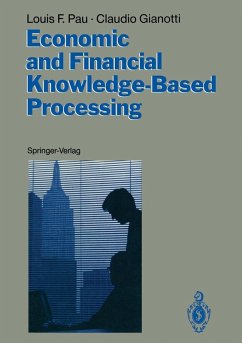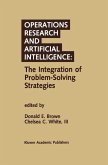40,95 €
40,95 €
inkl. MwSt.
Sofort per Download lieferbar

20 °P sammeln
40,95 €
Als Download kaufen

40,95 €
inkl. MwSt.
Sofort per Download lieferbar

20 °P sammeln
Jetzt verschenken
Alle Infos zum eBook verschenken
40,95 €
inkl. MwSt.
Sofort per Download lieferbar
Alle Infos zum eBook verschenken

20 °P sammeln
- Format: PDF
- Merkliste
- Auf die Merkliste
- Bewerten Bewerten
- Teilen
- Produkt teilen
- Produkterinnerung
- Produkterinnerung

Bitte loggen Sie sich zunächst in Ihr Kundenkonto ein oder registrieren Sie sich bei
bücher.de, um das eBook-Abo tolino select nutzen zu können.
Hier können Sie sich einloggen
Hier können Sie sich einloggen
Sie sind bereits eingeloggt. Klicken Sie auf 2. tolino select Abo, um fortzufahren.

Bitte loggen Sie sich zunächst in Ihr Kundenkonto ein oder registrieren Sie sich bei bücher.de, um das eBook-Abo tolino select nutzen zu können.
This book gives a survey of applications of artificial intelligence in banking, financial services and economics. It presents the tools, methods and application possibilities and includes an extensive survey of real projects.
- Geräte: PC
- ohne Kopierschutz
- eBook Hilfe
- Größe: 45MB
Andere Kunden interessierten sich auch für
![Representation and Management of Narrative Information (eBook, PDF) Representation and Management of Narrative Information (eBook, PDF)]() Gian Piero ZarriRepresentation and Management of Narrative Information (eBook, PDF)72,95 €
Gian Piero ZarriRepresentation and Management of Narrative Information (eBook, PDF)72,95 €![Rough Sets in Knowledge Discovery 2 (eBook, PDF) Rough Sets in Knowledge Discovery 2 (eBook, PDF)]() Rough Sets in Knowledge Discovery 2 (eBook, PDF)160,95 €
Rough Sets in Knowledge Discovery 2 (eBook, PDF)160,95 €![Operations Research and Artificial Intelligence: The Integration of Problem-Solving Strategies (eBook, PDF) Operations Research and Artificial Intelligence: The Integration of Problem-Solving Strategies (eBook, PDF)]() Operations Research and Artificial Intelligence: The Integration of Problem-Solving Strategies (eBook, PDF)160,95 €
Operations Research and Artificial Intelligence: The Integration of Problem-Solving Strategies (eBook, PDF)160,95 €![¿The Design of Human-Centered Artificial Intelligence for the Workplace (eBook, PDF) ¿The Design of Human-Centered Artificial Intelligence for the Workplace (eBook, PDF)]() ¿The Design of Human-Centered Artificial Intelligence for the Workplace (eBook, PDF)136,95 €
¿The Design of Human-Centered Artificial Intelligence for the Workplace (eBook, PDF)136,95 €![Socio-economic Impact of Artificial Intelligence (eBook, PDF) Socio-economic Impact of Artificial Intelligence (eBook, PDF)]() Socio-economic Impact of Artificial Intelligence (eBook, PDF)128,95 €
Socio-economic Impact of Artificial Intelligence (eBook, PDF)128,95 €![Fuzzy Set Theory - and Its Applications (eBook, PDF) Fuzzy Set Theory - and Its Applications (eBook, PDF)]() Hans-Jürgen ZimmermannFuzzy Set Theory - and Its Applications (eBook, PDF)68,95 €
Hans-Jürgen ZimmermannFuzzy Set Theory - and Its Applications (eBook, PDF)68,95 €![SAP® R/3® Interfacing using BAPIs (eBook, PDF) SAP® R/3® Interfacing using BAPIs (eBook, PDF)]() Gerd MoserSAP® R/3® Interfacing using BAPIs (eBook, PDF)40,95 €
Gerd MoserSAP® R/3® Interfacing using BAPIs (eBook, PDF)40,95 €-
-
-
This book gives a survey of applications of artificial intelligence in banking, financial services and economics. It presents the tools, methods and application possibilities and includes an extensive survey of real projects.
Dieser Download kann aus rechtlichen Gründen nur mit Rechnungsadresse in A, B, BG, CY, CZ, D, DK, EW, E, FIN, F, GR, HR, H, IRL, I, LT, L, LR, M, NL, PL, P, R, S, SLO, SK ausgeliefert werden.
Produktdetails
- Produktdetails
- Verlag: Springer Berlin Heidelberg
- Seitenzahl: 366
- Erscheinungstermin: 6. Dezember 2012
- Englisch
- ISBN-13: 9783642760020
- Artikelnr.: 53393706
- Verlag: Springer Berlin Heidelberg
- Seitenzahl: 366
- Erscheinungstermin: 6. Dezember 2012
- Englisch
- ISBN-13: 9783642760020
- Artikelnr.: 53393706
- Herstellerkennzeichnung Die Herstellerinformationen sind derzeit nicht verfügbar.
A reader's guide.- 0 Introduction.- 0.1 Introduction.- 0.2 The strategic challenge to banks and insurance.- 0.3 The strategic challenge to financial services.- 0.4 The strategic challenge to economic analysis and decision making.- 0.5 The strategic challenge for business management.- 0.6 Conclusion.- 1 Basic concepts.- 1.1 Introduction.- 1.2 Survey of AI applications in finance and economics.- 1.3 Case studies and examples.- 1.4 The mortgage loan credit granting case study.- 1.5 AI and Decision support.- 2 Applications of Artificial Intelligence in banking, financial services and economics.- 2.1 The motivations for the use of AI.- 2.2 Survey of development projects.- 2.3 Development and delivery environments.- 2.4 Generic domain utilities.- 2.5 Inference control and conflict resolution strategies.- 2.6 Table of projects.- 2.7 Project references.- 3 Knowledge Representation.- 3.1 Introduction.- 3.2 Case study: a tax adviser.- 3.3 The graph and tree data structures.- 3.4 Semantic networks.- 3.5 Logic.- 3.6 Rules.- 3.7 Frames.- 3.8 Temporal reasoning.- 4 Artificial Intelligence Programming Languages.- 4.1 Introduction.- 4.2 Language syntax and parsing.- 4.3 LISP.- 4.4 Prolog.- 4.5 Object-oriented programming.- 5 Search and causal analysis.- 5.1 Motivation.- 5.2 State-based representation of problems.- 5.3 Problem graphs.- 5.4 Search and knowledge.- 5.5 Search procedures.- 5.6 Application: a simple economic model in graph form.- 5.7 Simple propagation.- 5.8 Propagation with alternatives: depth-first.- 5.9 Introducing side effects: breadth-first.- 5.10 Case study: causal analysis in linear economic models.- 5.11 Heuristic search methods.- 6 Neural processing and inductive learnings.- 6.1 Introduction.- 6.2 Neural processing for learning and classification.- 6.3 Inductivelearning.- 6.4 Extensions to neural processing.- 7 Technical analysis for securities trading.- 7.1 Introduction.- 7.2 Curve generation by a syntactic grammar.- 7.3 Curve segmentation.- 7.4 Segmentation of noisy curves.- 7.5 Analysis evaluation rules.- 7.6 Technical analysis on several curves and software implementation.- 7.7 Time series analysis.- 7.8 Examples of concurrent trading rules.- 7.9 Off-line analysis for learning.- 7.10 Forecasting.- 7.11 Trade generation.- 8 Intelligent information screens.- 8.1 Introduction.- 8.2 Selective object-oriented data acquisition.- 8.3 Knowledge-based information screens.- 8.4 Knowledge-based filters for financial information screens.- 8.5 Information retrieval aspects.- 8.6 Data fusion.- 8.7 Correlation.- 9 Natural language front-ends to economic models.- 9.1 Introduction.- 9.2 Prolog parser for NL front-ends.- 9.3 Definite clause grammar in Prolog.- 9.4 Translation of DCG grammar rules into Prolog clauses.- 9.5 DCG parser.- 9.6 Reasoning from NL analysis.- 10 Trade selection with uncertain reasoning on technical indicators.- 10.1 Introduction.- 10.2 The theory of Dempster-Shafer.- 10.3 Pooling evidence.- 10.4 Application: pooling evidence about trading.- 11 Currency risk management.- 11.1 Introduction: risk planning over time.- 11.2 Single period model.- 11.3 Multi-period model.- 11.4 Knowledge-based risk management.- 11.5 Risk allocation procedure.- 12 Reasoning procedures in knowledge-based systems for economics and management.- 12.1 Introduction.- 12.2 Objects in decision analysis.- 12.3 Classification of decision methods.- 12.4 Logics and constraints.- 12.5 Truth maintenance as rational decision-making.- 12.6 Search over time and disequilibrium.- 12.7 Conflict resolution.- 12.8 Search over AND/OR graphs.- 12.9 Power relations and gaming for the selection of solutions.- Appendix 1 Software Codes.- Appendix 2 Predefined LISP and Prolog expressions 333.
A reader's guide.- 0 Introduction.- 0.1 Introduction.- 0.2 The strategic challenge to banks and insurance.- 0.3 The strategic challenge to financial services.- 0.4 The strategic challenge to economic analysis and decision making.- 0.5 The strategic challenge for business management.- 0.6 Conclusion.- 1 Basic concepts.- 1.1 Introduction.- 1.2 Survey of AI applications in finance and economics.- 1.3 Case studies and examples.- 1.4 The mortgage loan credit granting case study.- 1.5 AI and Decision support.- 2 Applications of Artificial Intelligence in banking, financial services and economics.- 2.1 The motivations for the use of AI.- 2.2 Survey of development projects.- 2.3 Development and delivery environments.- 2.4 Generic domain utilities.- 2.5 Inference control and conflict resolution strategies.- 2.6 Table of projects.- 2.7 Project references.- 3 Knowledge Representation.- 3.1 Introduction.- 3.2 Case study: a tax adviser.- 3.3 The graph and tree data structures.- 3.4 Semantic networks.- 3.5 Logic.- 3.6 Rules.- 3.7 Frames.- 3.8 Temporal reasoning.- 4 Artificial Intelligence Programming Languages.- 4.1 Introduction.- 4.2 Language syntax and parsing.- 4.3 LISP.- 4.4 Prolog.- 4.5 Object-oriented programming.- 5 Search and causal analysis.- 5.1 Motivation.- 5.2 State-based representation of problems.- 5.3 Problem graphs.- 5.4 Search and knowledge.- 5.5 Search procedures.- 5.6 Application: a simple economic model in graph form.- 5.7 Simple propagation.- 5.8 Propagation with alternatives: depth-first.- 5.9 Introducing side effects: breadth-first.- 5.10 Case study: causal analysis in linear economic models.- 5.11 Heuristic search methods.- 6 Neural processing and inductive learnings.- 6.1 Introduction.- 6.2 Neural processing for learning and classification.- 6.3 Inductivelearning.- 6.4 Extensions to neural processing.- 7 Technical analysis for securities trading.- 7.1 Introduction.- 7.2 Curve generation by a syntactic grammar.- 7.3 Curve segmentation.- 7.4 Segmentation of noisy curves.- 7.5 Analysis evaluation rules.- 7.6 Technical analysis on several curves and software implementation.- 7.7 Time series analysis.- 7.8 Examples of concurrent trading rules.- 7.9 Off-line analysis for learning.- 7.10 Forecasting.- 7.11 Trade generation.- 8 Intelligent information screens.- 8.1 Introduction.- 8.2 Selective object-oriented data acquisition.- 8.3 Knowledge-based information screens.- 8.4 Knowledge-based filters for financial information screens.- 8.5 Information retrieval aspects.- 8.6 Data fusion.- 8.7 Correlation.- 9 Natural language front-ends to economic models.- 9.1 Introduction.- 9.2 Prolog parser for NL front-ends.- 9.3 Definite clause grammar in Prolog.- 9.4 Translation of DCG grammar rules into Prolog clauses.- 9.5 DCG parser.- 9.6 Reasoning from NL analysis.- 10 Trade selection with uncertain reasoning on technical indicators.- 10.1 Introduction.- 10.2 The theory of Dempster-Shafer.- 10.3 Pooling evidence.- 10.4 Application: pooling evidence about trading.- 11 Currency risk management.- 11.1 Introduction: risk planning over time.- 11.2 Single period model.- 11.3 Multi-period model.- 11.4 Knowledge-based risk management.- 11.5 Risk allocation procedure.- 12 Reasoning procedures in knowledge-based systems for economics and management.- 12.1 Introduction.- 12.2 Objects in decision analysis.- 12.3 Classification of decision methods.- 12.4 Logics and constraints.- 12.5 Truth maintenance as rational decision-making.- 12.6 Search over time and disequilibrium.- 12.7 Conflict resolution.- 12.8 Search over AND/OR graphs.- 12.9 Power relations and gaming for the selection of solutions.- Appendix 1 Software Codes.- Appendix 2 Predefined LISP and Prolog expressions 333.







